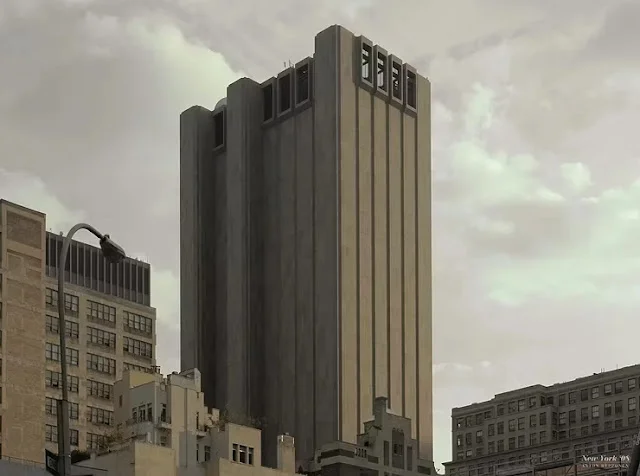Nestled in the heart of Lower Manhattan stands a peculiar 29-story skyscraper devoid of windows, shrouded in mystery and intrigue. Known as Titanpointe, the structure at 33 Thomas Street is an architectural anomaly that has puzzled New Yorkers for decades.


A Fortress in the Sky
Erected in 1974, this fortress-like edifice was designed to endure atomic attacks, initially intended to house critical telecommunications equipment. Conceived as a bastion against nuclear threats, it was the brainchild of the esteemed architectural firm John Carl Warnecke & Associates.
Rising 550 feet above the bustling streets of New York, this formidable monument, fashioned from gray concrete and granite, defies convention with its stark absence of windows. Unlike its neighboring buildings, whether residential or commercial, it remains cloaked in darkness, casting a foreboding silhouette against the urban backdrop. At night, its presence is eerie; by day, it casts a looming shadow, punctuated only by the soft hum from its square vents, often drowned out by the city’s ceaseless noise.
The Long Lines Building
Dubbed the “Long Lines Building,” 33 Thomas Street has long captivated the imagination of New Yorkers, standing out as one of the city’s most peculiar and iconic skyscrapers. Yet, beneath its enigmatic exterior lies a deeper mystery, concealed from the public eye and shrouded in secrecy.
Unlocking the Mystery of 33 Thomas Street
Beyond its austere facade, 33 Thomas Street harbors a clandestine secret. It appears to serve a purpose far beyond a mere telecommunications hub. Evidence from documents disclosed by NSA whistleblower Edward Snowden, along with architectural blueprints and testimonies of former AT&T personnel, hints at a covert role as an NSA surveillance outpost, codenamed Titanpointe.
Within the building’s confines, a crucial international gateway switch facilitates the routing of phone calls between the U.S. and countries around the globe. It is widely believed that the NSA has exploited this infrastructure, intercepting communications from a secure enclave within the AT&T stronghold. This clandestine surveillance initiative has targeted international entities such as the United Nations, the International Monetary Fund, and the World Bank, as well as monitoring numerous nations, including U.S. allies.
While AT&T’s cooperation with the NSA on surveillance activities is well-known, details about the precise role of facilities like 33 Thomas Street in executing covert programs remain elusive. However, revelations from the Snowden dossier offer unprecedented insights into the integration of NSA apparatus within AT&T’s New York network, shedding light on the methodologies and technologies employed by the agency to amass communication data from corporate systems.
The Implications of Surveillance
The NSA’s presence within this iconic skyscraper raises profound questions about the scope of surveillance in the contemporary world. Elizabeth Goitein, co-director of the liberty and national security program at the Brennan Center for Justice, asserts, “This is yet more proof that our communications service providers have become, whether willingly or unwillingly, an arm of the surveillance state.” The deep entanglement of the NSA within domestic communication infrastructure challenges the notion of surveillance being confined solely to non-American targets.
AT&T, Privacy, and Regulatory Oversight
AT&T’s close ties with the NSA have been extensively documented. However, the extent to which the NSA utilized AT&T’s facilities at 33 Thomas Street remains ambiguous, raising concerns about the breadth of government surveillance within the premises.
Reports by The New York Times and ProPublica in August 2015 highlighted AT&T’s longstanding collaboration with the NSA, earning accolades from the agency for its unwavering assistance. Yet, neither the Snowden disclosures nor subsequent reports definitively confirm the NSA’s utilization of AT&T’s space or equipment. Intriguingly, while AT&T Inc. owns the land at 33 Thomas, it only possesses approximately 87 percent of the floor space, with Verizon owning the remainder.
The NSA’s involvement in surveillance activities within 33 Thomas Street underscores significant legal and ethical dilemmas. The structure stands as a testament to the delicate balance between privacy and security in our interconnected society, highlighting the challenges of maintaining adequate oversight amidst advancing technology and government surveillance.
A Symbol of Modern Complexity
In summary, 33 Thomas Street remains a symbol of mystery and intrigue in the New York City skyline, embodying both the evolution of telecommunications and the complexities of contemporary surveillance. While the full extent of its role in governmental espionage may forever remain veiled, it serves as a poignant reminder of the intricate interplay between privacy and security in our modern age.
By unraveling the secrets of 33 Thomas Street, we gain a deeper understanding of the hidden forces shaping our world, prompting us to question the boundaries of surveillance and the preservation of our privacy in an era of unprecedented technological advancement.
